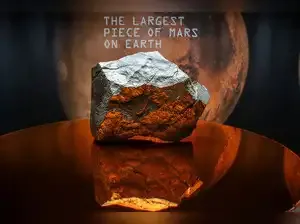The biggest Martian meteorite ever discovered on Earth is going under the hammer this Wednesday at Sotheby’s in New York, with an estimated price tag between $2 million and $4 million, according to the Associated Press.
The 54-pound (25-kilogram) meteorite, officially named NWA 16788, is the highlight of Sotheby’s natural history-themed sale, part of its annual Geek Week 2025 series. According to the auction house, it’s not just the size that makes it exceptional, it’s also believed to be the largest known fragment of Mars ever found on our planet, measuring nearly 15 inches by 11 inches by 6 inches.
“This Martian meteorite is the largest piece of Mars we have ever found by a long shot,” said Cassandra Hatton, vice chairman for science and natural history at Sotheby’s. “So it's more than double the size of what we previously thought was the largest piece of Mars.”
Hatton explained that the rock likely originated from a massive asteroid impact that blasted it off Mars’ surface. It then travelled 140 million miles through space before crashing into the Sahara desert. A meteorite hunter found it in Niger in November 2023.
With its red, brown, and grey hues, the meteorite is 70% larger than the next biggest Martian sample found on Earth and accounts for nearly 7% of all verified Martian material known to exist here, Sotheby’s said. Out of more than 77,000 officially recognised meteorites discovered globally, only 400 are known to have come from Mars.
To confirm its origin, a fragment was removed and analysed in a specialist lab. Scientists matched its chemical makeup to known Martian meteorites, originally identified using data from NASA’s Viking lander mission in 1976. The sample was classified as an olivine-microgabbroic shergottite, a rock formed by the slow cooling of Martian magma. It features a coarse texture and contains pyroxene and olivine minerals.
The rock’s glassy outer surface hints at the intense heat it endured while plummeting through Earth’s atmosphere. “So that was their first clue that this wasn’t just some big rock on the ground,” Hatton said.
Previously displayed at the Italian Space Agency in Rome, the meteorite’s current owner has not been revealed. Sotheby’s noted that while the exact timing of its fall to Earth is unknown, recent testing suggests the impact was relatively recent.
The Martian rock will be auctioned alongside another attention-grabbing specimen: a juvenile Ceratosaurus nasicornis skeleton, standing over 6 feet tall and nearly 11 feet long. Discovered in 1996 near Laramie, Wyoming, the skeleton was reconstructed from nearly 140 original bones and additional sculpted parts. Dating back around 150 million years to the late Jurassic period, its auction estimate ranges from $4 million to $6 million.
Ceratosaurus was a bipedal predator with short arms, somewhat resembling a smaller version of the Tyrannosaurus rex. While a typical Ceratosaurus could grow up to 25 feet, the T. rex could reach up to 40 feet in length.
The skeleton was acquired last year by Fossilogic, a fossil preparation and mounting company based in Utah.
Sotheby’s Geek Week 2025 auction includes a total of 122 lots, featuring other meteorites, fossils, and rare minerals.
With inputs from AP
The 54-pound (25-kilogram) meteorite, officially named NWA 16788, is the highlight of Sotheby’s natural history-themed sale, part of its annual Geek Week 2025 series. According to the auction house, it’s not just the size that makes it exceptional, it’s also believed to be the largest known fragment of Mars ever found on our planet, measuring nearly 15 inches by 11 inches by 6 inches.
“This Martian meteorite is the largest piece of Mars we have ever found by a long shot,” said Cassandra Hatton, vice chairman for science and natural history at Sotheby’s. “So it's more than double the size of what we previously thought was the largest piece of Mars.”
Hatton explained that the rock likely originated from a massive asteroid impact that blasted it off Mars’ surface. It then travelled 140 million miles through space before crashing into the Sahara desert. A meteorite hunter found it in Niger in November 2023.
With its red, brown, and grey hues, the meteorite is 70% larger than the next biggest Martian sample found on Earth and accounts for nearly 7% of all verified Martian material known to exist here, Sotheby’s said. Out of more than 77,000 officially recognised meteorites discovered globally, only 400 are known to have come from Mars.
To confirm its origin, a fragment was removed and analysed in a specialist lab. Scientists matched its chemical makeup to known Martian meteorites, originally identified using data from NASA’s Viking lander mission in 1976. The sample was classified as an olivine-microgabbroic shergottite, a rock formed by the slow cooling of Martian magma. It features a coarse texture and contains pyroxene and olivine minerals.
The rock’s glassy outer surface hints at the intense heat it endured while plummeting through Earth’s atmosphere. “So that was their first clue that this wasn’t just some big rock on the ground,” Hatton said.
Previously displayed at the Italian Space Agency in Rome, the meteorite’s current owner has not been revealed. Sotheby’s noted that while the exact timing of its fall to Earth is unknown, recent testing suggests the impact was relatively recent.
The Martian rock will be auctioned alongside another attention-grabbing specimen: a juvenile Ceratosaurus nasicornis skeleton, standing over 6 feet tall and nearly 11 feet long. Discovered in 1996 near Laramie, Wyoming, the skeleton was reconstructed from nearly 140 original bones and additional sculpted parts. Dating back around 150 million years to the late Jurassic period, its auction estimate ranges from $4 million to $6 million.
Ceratosaurus was a bipedal predator with short arms, somewhat resembling a smaller version of the Tyrannosaurus rex. While a typical Ceratosaurus could grow up to 25 feet, the T. rex could reach up to 40 feet in length.
The skeleton was acquired last year by Fossilogic, a fossil preparation and mounting company based in Utah.
Sotheby’s Geek Week 2025 auction includes a total of 122 lots, featuring other meteorites, fossils, and rare minerals.
With inputs from AP





